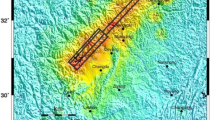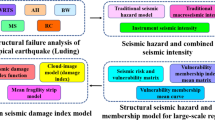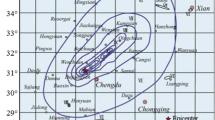Abstract
To deeply explore the seismic vulnerability characteristics of typical structures and obtain the differences in the seismic capacity of multiple structural categories in actual earthquakes, combined with mathematical statistics and probabilistic damage model analysis methods, the bulk of collection and statistics were made on the structural seismic damage observation data (98,051.8122 × 104 m2 and 995,269 buildings) of 213 destructive earthquakes in China from 1975 to 2013. Seismic damage sample databases of wooden roof truss structures, adobe and timber structures, brick wood structures, masonry structures, RC structures, and bottom frame seismic wall masonry structure were established. A seismic damage investigation and analysis were conducted. All samples’ vulnerability grades were evaluated using the latest version of the Chinese seismic intensity scale (CSIS-20). The actual damage vulnerability probability matrix and surface model of structures in multiple intensity regions based on the investigated area and quantity parameters were established. A nonlinear regression prediction model analysis method was proposed. A typical structural vulnerability prediction model considering the failure ratio and exceedance probability in the multi-intensity region was established and verified by the earthquake damage database. In addition, a vulnerability matrix prediction model considering updating the mean vulnerability index parameter was proposed, and a comparison model of the vulnerability prediction matrix of typical regional structures was developed.
























Similar content being viewed by others
References
Altindal A, Karimzadeh S, Erberik MA, Askan A, Anil O, Kockar MK, Sahmaran M (2021) A case study for probabilistic seismic risk assessment of earthquake-prone old urban centers. IInt J Disaster Risk Reduc 61:102376. https://doi.org/10.1016/j.ijdrr.2021.102376
Avila-Haro JA, Gonzalez-Drigo R, Vargas-Alzate YF, Pujades L, Barbat A (2022) Probabilistic seismic assessment of a high-rise URM building. J Build Eng 45:103344. https://doi.org/10.1016/j.jobe.2021.103344
Biglari M, Formisano A, Hashemi BH (2021) Empirical fragility curves of engineered steel and RC residential buildings after Mw 7.3 2017 Sarpol-e-zahab earthquake. Bull Earthq Eng 19:2671–2689. https://doi.org/10.1007/s10518-021-01090-4
Biglari M, Formisano A, Davino A (2022) Seismic vulnerability assessment and fragility analysis of Iranian historical mosques in Kermanshah city. J Build Eng 45:103673. https://doi.org/10.1016/j.jobe.2021.103673
Bilgin H, Shkodrani N, Hysenlliu M, Ozmen HB, Isik E, Harirchian E (2022) Damage and performance evaluation of masonry buildings constructed in 1970s during the 2019 Albania earthquakes. Eng Fail Anal 131:105824. https://doi.org/10.1016/j.engfailanal.2021.105824
Brando G, De-Matteis G, Spacone E (2017) Predictive model for the seismic vulnerability assessment of small historic centres: application to the inner Abruzzi region in Italy. Eng Struct 153:81–96. https://doi.org/10.1016/j.engstruct.2017.10.013
Brando G, Cianchino G, Rapone D, Spacone E, Biondi S (2021) A CARTIS-based method for the rapid seismic vulnerability assessment of minor Italian historical centres. Int J Disaster Risk Reduct 63:102478. https://doi.org/10.1016/j.ijdrr.2021.102478
Briceño C, Noel MF, Chácara C, Aguilar R (2021) Integration of non-destructive testing, numerical simulations, and simplified analytical tools for assessing the structural performance of historical adobe buildings. Constr Build Mater 290:123224. https://doi.org/10.1016/j.conbuildmat.2021.123224
Chen H, Xie QC, Li ZQ, Xue W, Liu K (2017) Seismic damage to structures in the 2015 Nepal earthquake sequences. J Earthquake Eng 21(4):551–578. https://doi.org/10.1080/13632469.2016.1185055
Chieffo N, Mosoarca M, Formisano A, Lourenço PB, Milani G (2021) The effect of ground motion vertical component on the seismic response of historical masonry buildings: the case study of the Banloc Castle in Romania. Eng Struct 249:113346. https://doi.org/10.1016/j.engstruct.2021.113346
China Earthquake Administration and National Bureau of Statistics (1996) Compilation of loss assessment for earthquake disasters in mainland China (1990–1995). Earthquake Press, Beijing
China Earthquake Administration and National Bureau of Statistics (2001) Compilation of loss assessment for earthquake disasters in mainland China (1996–2000). Earthquake Press, Beijing
China Earthquake Administration and National Bureau of Statistics (2005) Compilation of loss assessment for earthquake disasters in mainland China (2001–2005). Earthquake Press, Beijing
Clarke R, Carey B (2021) Seismic fragility functions for a pervasive unique form of construction with very high potential for social losses in Trinidad and Tobago: two-story houses. Earthq Spectra. https://doi.org/10.1177/87552930211047258
D’Amico S, Meroni F, Sousa ML, Zonno G (2016) Building vulnerability and seismic risk analysis in the urban area of Mt. Etna volcano (Italy). Bull Earthq Eng 14(7):2031–2045. https://doi.org/10.1007/s10518-015-9804-4
Dai JW, Chen JG, Zhang CX, Nie GB, Liu YB (2020) Seismic damage investigation and seismic performance study of Lushan middle school gymnasium. J Perform Constr Facil 34(3):04020041. https://doi.org/10.1061/(ASCE)CF.1943-5509.0001431
Domaneschi M, Noori AZ, Pietropinto MV, Cimellaro GP (2021) Seismic vulnerability assessment of existing school buildings. Comput Struct 248:106522. https://doi.org/10.1016/j.compstruc.2021.106522
Eudave RR, Ferreira TM (2021) On the potential of using the Mexican National Catalogue of Historical Monuments for assessing the seismic vulnerability of existing buildings: a proof-of-concept study. Bull Earthq Eng 19(12):4945–4978. https://doi.org/10.1007/s10518-021-01154-5
Ferreira TM, Vicente R, Mendes JAR, Varum H, Costa A (2013) Seismic vulnerability assessment of historical urban centres: case study of the old city centre in Seixal, Portugal. Bull Earthquake Eng 11(5):1753–1773. https://doi.org/10.1007/s10518-013-9447-2
Gaudio CD, Scala SA, Ricci P, Verderame GM (2021) Evolution of the seismic vulnerability of masonry buildings based on the damage data from L’Aquila 2009 event. Bull Earthq Eng 19(11):4435–4470. https://doi.org/10.1007/s10518-021-01132-x
Godínez-Domínguez EA, Tena-Colunga A, Pérez-Rocha LE, Archundia-Aranda HI, Bernal AG, Ruiz-Torres RPR (2021) The September 7, 2017 Tehuantepec, Mexico, earthquake: damage assessment in masonry structures for housing. Int J Disaster Risk Reduct 56:102123. https://doi.org/10.1016/j.ijdrr.2021.102123
Grigoratos L, Monteiro R, Ceresa P, Meo AD, Faravelli M, Borzi B (2021) Crowdsourcing exposure data for seismic vulnerability asessment in developing countries. J Earthquake Eng 25(5):835–852. https://doi.org/10.1080/13632469.2018.1537901
Halder L, Dutta SC, Sharma RP, Bhattacharya S (2021) Lessons learnt from post-earthquake damage study of Northeast India and Nepal during last ten years: 2021 Assam earthquake, 2020 Mizoram earthquake, 2017 Ambasa earthquake, 2016 Manipur earthquake, 2015 Nepal earthquake, and 2011 Sikkim earthquake. Soil Dyn Earthq Eng 151:106990. https://doi.org/10.1016/j.soildyn.2021.106990
Kassem MM, Nazri FM, Farsangi EN, Tan CG (2021) Comparative seismic RISK assessment of existing RC buildings using seismic vulnerability index approach. Structures 32:889–913. https://doi.org/10.1016/j.istruc.2021.03.032
Kechidi S, Castro JM, Monteiro R, Marques M, Yelles K, Bourahla N, Hamdache M (2021) Development of exposure datasets for earthquake damage and risk modelling: the case study of northern Algeria. Bull Earthq Eng 19(12):5253–5283. https://doi.org/10.1007/s10518-021-01161-6
Kita A, Cavalagli N, Venanzi I, Ubertini F (2021) A new method for earthquake-induced damage identification in historic masonry towers combining OMA and IDA. Bull Earthq Eng 19(12):5307–5337. https://doi.org/10.1007/s10518-021-01167-0
Lagomarsino S, Cattari S, Ottonelli D (2021) The heuristic vulnerability model: fragility curves for masonry buildings. Bull Earthq Eng 19(8):3129–3163. https://doi.org/10.1007/s10518-021-01063-7
Li SQ, Chen YS (2020) Analysis of the probability matrix model for the seismic damage vulnerability of empirical structures. Nat Hazards 104(1):705–730. https://doi.org/10.1007/s11069-020-04187-2
Li SQ, Yu TL, Chen YS (2019) Comparative analysis of the empirical seismic vulnerability of typical structures in multiple intensity zone. Arch Civ Eng 65(3):167–183. https://doi.org/10.2478/ace-2019-0042
Li SQ, Chen YS, Yu TL (2021a) Comparison of macroseismic intensity scales by considering empirical observations of structural seismic damage. Earthq Spectra 37(1):449–485. https://doi.org/10.1177/8755293020944174
Li SQ, Liu HB, Chen YS (2021b) Vulnerability models of brick and wood structures considering empirical seismic damage observations. Structures 34:2544–2565. https://doi.org/10.1016/j.istruc.2021.09.023
Lovon H, Silva V, Vicente R, Ferreira TM, Costa AA (2021) Characterisation of the masonry building stock in Portugal for earthquake risk assessment. Eng Struct 233:111857. https://doi.org/10.1016/j.engstruct.2021.111857
Menichini G, Nistri V, Boschi S, Monte ED, Orlando M, Vignoli A (2022) Calibration of vulnerability and fragility curves from moderate intensity Italian earthquake damage data. Int J Disaster Risk Reduct 67:102676. https://doi.org/10.1016/j.ijdrr.2021.102676
Mulas MG, Stroffolini L, Martinelli P (2021) Vulnerability and retrofitting of torsionally deformable RC buildings: a case study. Structures 32:861–875. https://doi.org/10.1016/j.istruc.2021.03.063
Polese M, Marcolini M, Zuccaro G, Cacace F (2015) Mechanism based assessment of damage-dependent fragility curves for RC building classes. Bull Earthq Eng 13(5):1323–1345. https://doi.org/10.1007/s10518-014-9663-4
Qu Z, Dutu A, Zhong JR, Sun JJ (2015) Seismic damage of Masonry Infilled Timber Houses in the 2013 M7.0 Lushan Earthquake in China. Earthquake Spectra 31(3): 1859–1874. https://doi.org/10.1193/012914EQS023T
Ruggieri S, Tosto C, Rosati G, Uva G, Ferro A (2020) Seismic vulnerability analysis of masonry churches in piemonte after 2003 Valle Scrivia earthquake: post-event screening and situation 17 Years later. Int J Architect Heritage. https://doi.org/10.1080/15583058.2020.1841366
Ruggieri S, Cardellicchio A, Leggieri V, Uva G (2021) Machine-learning based vulnerability analysis of existing buildings. Autom Constr 132:103936. https://doi.org/10.1016/j.autcon.2021.103936
Saretta Y, Sbrogiò L, Valluzzi MR (2021) Seismic response of masonry buildings in historical centres struck by the 2016 Central Italy earthquake. Calibration of a vulnerability model for strengthened conditions. Construct Build Mater 299:123911. https://doi.org/10.1016/j.conbuildmat.2021.123911
Shin J, Choi I, Kim J (2021) Rapid decision-making tool of piloti-type RC building structure for seismic performance evaluation and retrofit strategy using multi-dimensional structural parameter surfaces. Soil Dyn Earthq Eng 151:106978. https://doi.org/10.1016/j.soildyn.2021.106978
Stocchi A, Giry C, Capdevielle S, Zentner I, Nayman E, Ragueneau F (2021) A simplified nonlinear modelling strategy to generate fragility curves for old masonry buildings. Comput Struct 254:106579. https://doi.org/10.1016/j.compstruc.2021.106579
Sun BT, Spencer BF, Yan PL, Chen X, Zhang GX (2021) Analysis of the seismic vulnerability of buildings in the Lushan Ms7.0 Earthquake in the Sichuan Province of China. J Earthquake Eng. https://doi.org/10.1080/13632469.2019.1692742
Zizi M, Corlito V, Lourenço PB, Matteis GD (2021) Seismic vulnerability of masonry churches in Abruzzi region, Italy. Structures 32:662–680. https://doi.org/10.1016/j.istruc.2021.03.013
Acknowledgements
The basic data of this study were derived from the seismic damage investigation database of the China Earthquake Administration (CAE) and the Wenchuan earthquake damage investigation team of the Institute of Engineering Mechanics of CAE. I would like to express my sincere gratitude to them. In addition, the research described in this paper was financially supported by the Basic Scientific Research Business Expenses of Provincial Universities in Heilongjiang Province (2021-KYYWF-0044) and Key Laboratory of Functional Inorganic Material Chemistry (Heilongjiang University), Ministry of Education.
Funding
The authors have not disclosed any funding.
Author information
Authors and Affiliations
Corresponding authors
Ethics declarations
Conflict of interest
The authors have not disclosed any competing interest.
Additional information
Publisher's Note
Springer Nature remains neutral with regard to jurisdictional claims in published maps and institutional affiliations.
Supplementary Information
Below is the link to the electronic supplementary material.
Rights and permissions
About this article
Cite this article
Li, SQ., Liu, HB. Vulnerability prediction model of typical structures considering empirical seismic damage observation data. Bull Earthquake Eng 20, 5161–5203 (2022). https://doi.org/10.1007/s10518-022-01395-y
Received:
Accepted:
Published:
Issue Date:
DOI: https://doi.org/10.1007/s10518-022-01395-y




